
Browse an alphabetical list of film clips that feature important events before, during, and after the Holocaust and World War II. These clips include home movies, propaganda films, newsreels, and more.
<< Previous | Displaying results 26-50 of 191 for "Film" | Next >>
British troops liberated the Bergen-Belsen concentration camp in Germany in April 1945. They filmed statements from members of their own forces. In this British military footage, British army chaplain T.J. Stretch recounts his impressions of the camp.
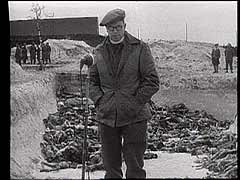
British Chief Prosecutor Sir Hartley Shawcross makes a final plea to the International Military Tribunal.
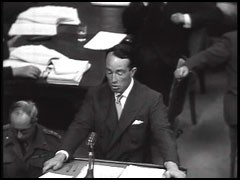
In July 1947 in France, 4,500 Jewish refugees from displaced persons camps in Germany boarded the "Exodus 1947" and attempted to sail (without permission to land) to Palestine, which was under British mandate. The British intercepted the ship off the coast and forced it to anchor in Haifa, where British soldiers removed the Jewish refugees. After British authorities failed to force France to accept the refugees, the refugees were returned to DP camps in Germany. The plight of the "Exodus" passengers became…
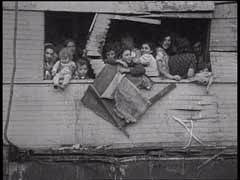
Clip from George Stevens' "The Nazi Concentration Camps." This German film footage was compiled as evidence and used by the prosecution at the Nuremberg trials.
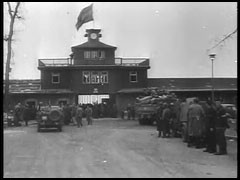
After the Germans established the Warsaw ghetto in October 1940, conditions deteriorated rapidly. The Germans strictly controlled the movement of goods into and out of the ghetto. There was not enough food to feed the ghetto residents. At great personal risk, many Jews attempted to smuggle in food. The German food ration for Warsaw ghetto inhabitants amounted to less than 10 percent of the ration for a German citizen. Thousands of Jew died in Warsaw each month because of starvation or disease.
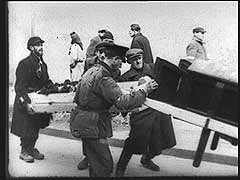
The Nazis sealed the Warsaw ghetto in mid-November 1940. German-induced overcrowding and food shortages led to an extremely high mortality rate in the ghetto. Almost 30 percent of the population of Warsaw was packed into 2.4 percent of the city's area. The Germans set a food ration for Jews at just 181 calories a day. By August 1941, more than 5,000 people a month succumbed to starvation and disease.
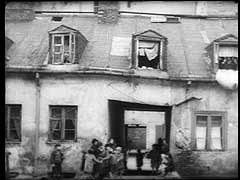
The Nazis sealed the Warsaw ghetto in mid-November 1940. German-induced overcrowding and food shortages led to an extremely high mortality rate in the ghetto. Almost 30 percent of the population of Warsaw was packed into 2.4 percent of the city's area. The Germans set a food ration for Jews at just 181 calories a day. By August 1941, more than 5,000 people a month succumbed to starvation and disease.
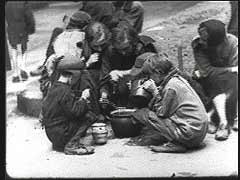
Ante Pavelic was a Croatian fascist leader who headed a pro-German government in Croatia from 1941 until 1945. This captured German newsreel shows Pavelic walking through an adoring crowd and reviewing his units. Under Pavelic's rule, the Croatian government killed hundreds of thousands of Serbs, Jews, and Roma (Gypsies). Pavelic fled to Argentina after the war. He died in 1959 from wounds he received in an assassination attempt two years earlier.
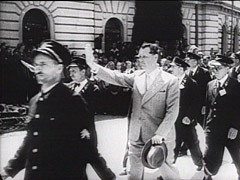
US prosecutor Thomas Dodd cross examines defandant Walter Funk, former president of the German national bank. Dodd questions Funk about the possessions confiscated from concentration camp prisoners and elsewhere in German-occupied territories.
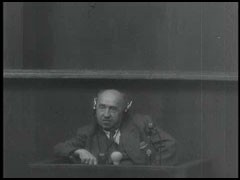
The Dachau concentration camp, northwest of Munich, Germany, was the first regular concentration camp the Nazis established in 1933. About twelve years later, on April 29, 1945, US armed forces liberated the camp. There were about 30,000 starving prisoners in the camp at that time. The film seen here was edited from original footage shot by Allied cameramen as liberating troops entered Dachau. It was discovered in the archives of the Imperial War Museum in 1984 and was never completed.
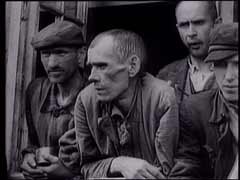
A bridge connected areas of the Warsaw ghetto to prevent Jews from entering the streets that were not part of the ghetto. Before the ghetto was sealed, the few entrances and exits had checkpoints. In the early months of the ghetto, life had the appearance of normalcy, but very soon the lack of food and adequate housing began to take its toll.
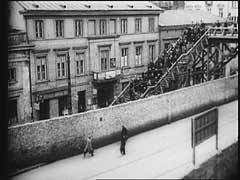
Massive Allied landings of air- and sea-borne forces on five Normandy beaches (codenamed Utah, Omaha, Gold, Juno, and Sword) began on June 6, 1944 (D-Day). The purpose of the invasion was to establish a bridgehead from which Allied forces could break out and liberate France. By the end of the operation's first day, some 150,000 troops were ashore in Normandy. This footage shows Allied forces landing on the Normandy beaches.
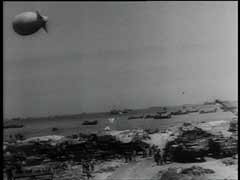
Allied air superiority over Germany was a decisive factor in the success of the D-Day (June 6, 1944) landings in France. This footage shows the Allied bombing of suspected German positions during the battle. Allied air attacks both supported Allied ground operations in Normandy and prevented German reinforcements from reaching the area. The Allies would liberate most of France by the end of August 1944.
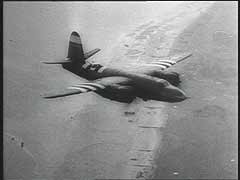
German forces invaded western Europe in May 1940. As part of their strategy to defeat Britain and France, German forces invaded neutral Belgium. Little more than two weeks after the German invasion of Belgium, King Leopold III ordered the surrender of the Belgian army. In this footage a Belgian officer signs the surrender and thousands of refugees flood the streets as German forces move through Belgium.

Defendant Hans Frank gives testimony to his defense lawyer during the Nuremberg trial about his leadership roles during the Third Reich.
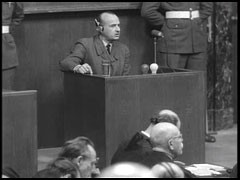
Defendant Hermann Göring, seated at left in the dock, listens as US Chief Prosecutor Robert Jackson interrogates witness Albert Kesselring about the Luftwaffe (German Air Force).
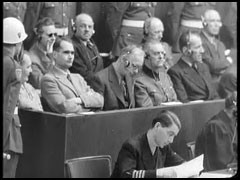
Defendant Julius Streicher is sworn in as a witness during the International Military Tribunal at Nuremberg.

After the defeat of Germany, the Allies tried leading state and party officials and military commanders of the Third Reich before a tribunal of military judges from the Soviet Union, Great Britain, France, and the United States. This International Military Tribunal tried 22 major war criminals during what is commonly known as the Nuremberg Trial, which lasted from November 1945 to October 1946. This footage shows the accused entering pleas following their indictment on charges of crimes against peace, war…
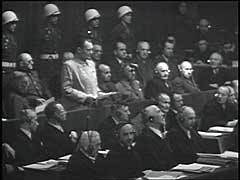
The International Military Tribunal defendants in the dock at Nuremberg.
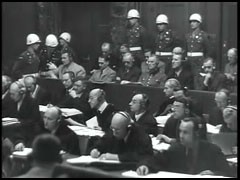
The Romanian government was allied with Nazi Germany, but it generally did not deport Romanian Jews to German-occupied territory. Instead, Romania systematically concentrated and deported the Jews of Bessarabia and northern Bukovina to Romanian-occupied areas of the Ukraine. Here, Jews from the Bessarabian town of Balti are assembled in collection camps during the deportations. By the end of May 1942, Romanian security forces had killed or deported most of the Jews in the area. Only about 200 Jews remained…
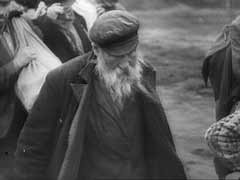
Jews were deported from Kavala, Seres, and Drama in Bulgarian-occupied Thrace. Some 3,000 Jews were taken to Drama and herded onto trains without food or water for transport to a camp in Gorna Dzumaya. The Jews were probably then taken to the Bulgarian port of Lom on the Danube River, where they boarded ships for Vienna. From there, the Nazis deported them to the Treblinka killing center.
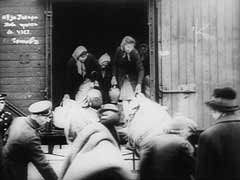
Czech resistance fighters attacked Reinhard Heydrich, acting governor of the Protectorate of Bohemia and Moravia, in an ambush near Prague in May 1942. Heydrich died of his wounds on June 4, 1942. In retaliation for the attack, the Germans destroyed the village of Lidice on June 10, 1942. The Germans shot all the men in the village and deported most of the women and children to camps in Germany. This footage shows destroyed homes and German officials inspecting the remains of the village.
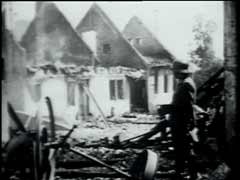
After World War II, the Allies repatriated millions of displaced persons (DPs) back to their countries of origin. But hundreds of thousands of people, including more than 250,000 Jewish refugees, could not or would not return. Most Jewish DPs preferred to leave Europe for either Palestine or the United States. The United Nations Relief and Rehabilitation Administration (UNRRA) housed them in camps in occupied Germany and Austria until they could be resettled. Here, Jewish DPs raise their children in the…

At the end of World War II, the Allied powers in Europe repatriated from Germany millions of displaced persons (DPs). The remaining 1.5 to 2 million DPs—both Jews and non-Jews—refused or were unable to return to their prewar homes. Immigration restrictions precluded the large-scale admission of these refugees to other European countries and the United States. They remained in occupied Germany until they could arrange to settle in another country. In this footage, filmed more than four years…
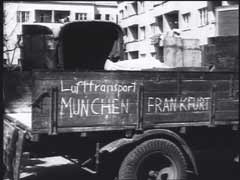
German Einsatzgruppen operated in German-occupied territories in eastern Europe during World War II. This rare footage shows a unit during a massacre in Liepaja, Latvia. The film was taken, contrary to orders, by a German soldier. Before the war, the Jewish population of Liepaja stood at more than 7,000 residents. Einsatzgruppen shot almost the entire Jewish population of the town. When the Soviet army liberated the city in 1945, just 20 to 30 Jews remained. Einsatzgruppen carried out various security…
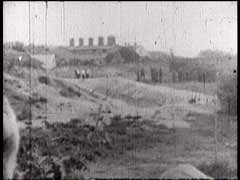
We would like to thank Crown Family Philanthropies, Abe and Ida Cooper Foundation, the Claims Conference, EVZ, and BMF for supporting the ongoing work to create content and resources for the Holocaust Encyclopedia. View the list of donor acknowledgement.